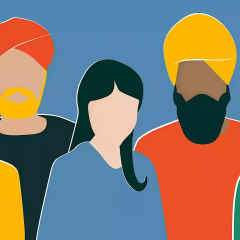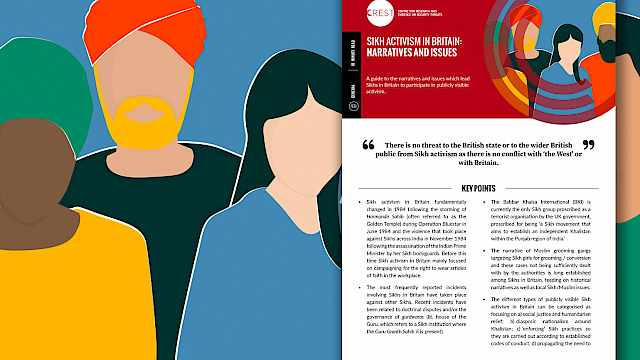This report examines the following questions:
- Framing Sikh activism in Britain: Which incidents have taken place in Britain involving Sikhs including protests and flashpoints and how have these impacted on the discourse around Sikhs in Britain?
- Narratives and issues: Which narratives and issues are relevant in encouraging Sikhs in Britain to participate in these protests and incidents? Are there specific political /religious narratives and how are these linked to cultural issues?
- The transmission of narratives: How are these narratives transmitted? How are Sikh organisations/institutions involved?
- Types of Sikh activism: Are there different types of Sikh activism and what are the key issues of focus?
- The impact of Sikh activism in Britain: What is the impact of Sikh activism on the British public?
Framing Sikh activism in Britain
Sikh activism in Britain fundamentally changed in 1984 following the storming of Harmandir Sahib (often referred to as the Golden Temple) during Operation Bluestar in June 1984 and the violence that took place against Sikhs across India in November 1984 following the assassination of the Indian Prime Minister by her Sikh bodyguards. From a community who generally supported India and who were focused on campaigning for the right to maintain Sikh symbols in Britain, anger about the events of 1984 moved many Sikhs in Britain to protest about these incidents and about the lack of recourse from the Indian state.
The most frequently reported incidents of violence involving Sikhs in Britain have taken place against other Sikhs. In the immediate aftermath of 1984, some incidents of fatal political violence were committed in Britain by Sikhs supporting the establishment of a Sikh state, Khalistan, against Sikhs opposing this. Recent incidents have been related to doctrinal disputes and/or the governance of gurdwaras (lit. house of the Guru, refers to a Sikh institution where the Guru Granth Sahib Ji is present). It appears that it is political, doctrinal, personal, factional and/or governance-related Sikh vigilantism which is most likely to result in violence in the future.
Sikhs have most frequently been labelled as ‘extremists’, ‘fanatics’, ‘militants’, ‘fundamentalists’ and ‘radicals’ in both British and Indian media when campaigning against the state (in particular against the British colonial and Indian postcolonial state).
The bombing of the Air India flight 182 on 23rd June 1985 which caused the loss of 329 lives, remains the only large scale terrorist incident outside of India which has led to the conviction of a Sikh (Inderjit Singh Reyat, who has joint British and Canadian citizenship).
Narratives and issues
A number of political, religious and cultural narratives have led to Sikh activism, including the lack of recourse for the events of 1984, instances of beadbi (disrespect) being shown to the Guru Granth Sahib Ji (regarded by Sikhs as the eternal living Guru, in the form of a book), the need to maintain the izzat (honour) of the Sikh community and the wish to uphold edicts issued from the seat of Sikh temporal authority (the Akal Takht).
For Sikhs, ‘1984’ can refer to the events of either June and/or November. Activism around 1984 does not automatically indicate support for the idea of Khalistan.
Many of the ‘Sikh on Sikh’ issues are a consequence of a) the contested nature of religious authority within the Sikh tradition and/or b) local factional politics which most often relate to personal and familial disputes. A number of recent issues have been caused by the lack of clarity around the processes by which Akal Takht edicts are disseminated to the Sikh diaspora. The large number of ‘Sikh on Sikh’ incidents highlights that Sikhs in Britain (and the diaspora) are often unable to address differences of opinion about Sikh doctrine and/or diverse opinions before incidents occur.
Cultural dimensions including the emphasis of maintaining izzat impact on Sikh activism with some male Sikh activists feeling the need to demonstrate their masculinity by ‘protecting the honour’ of Sikh females. Some Sikh activists also feel the need to continually maintain their honour among activist circles by regularly participating in activist events.
Concepts often used in relation to other religious traditions like ‘fundamentalism’ and ‘martyrdom’ have substantially different meanings in the Sikh tradition. For instance, martyrdom in the Sikh tradition is primarily regarded as an act of resistance and rebellion rather than being viewed as a guarantee of an afterlife in paradise. With no concept of apostasy or need to proselytise to ‘non-believers’ in the Sikh tradition, a number of recent protests/incidents relating to religious narratives have taken place against those seen to have been excommunicated by the Akal Takht (the seat of Sikh temporal authority) or to have committed acts of beadbi against the Guru Granth Sahib Ji.
The narrative of Muslim grooming gangs targeting Sikh girls for grooming/conversion, and these cases not being sufficiently dealt with by the authorities, often feeds on existing historical narratives and contemporary Sikh/Muslim tensions. These narratives along with the promotion of Sikhs by the far-right have led some Sikhs to engage with far-right representatives and organisations.
Local context plays a key role in Sikh activism. In the UK, the Midlands has the highest concentration of Sikh organisations and gurdwaras (lit. house of the Guru, refers to a Sikh institution where the Guru Granth Sahib Ji is present) which impacts on the number of activities, networks, incidents and opportunities to mobilise in this region.
The transmission of narratives
There are few places and spaces within the British education system for Sikhs in Britain to examine their heritage and history. This often leads them to undertake such engagement and learning on an ad hoc basis, primarily online.
Narratives which lead to activism are transmitted in different ways, through families, organised events, lectures, camps, music and Sikh media (newspapers, broadcast, online and social media). The now rapid transmission through social media of ‘issues of concern’, incidents and/or factional disputes occurring anywhere in the Sikh diaspora, often demands immediate responses from Sikh activists in order for them to continually demonstrate their status as activists. Once aware of these issues, geographical access to established organisations and networks plays an important role in facilitating mobilisation around these issues and disputes.
There are a wide variety of different types of Sikh organisations and institutions operating in Britain focusing on political engagement, doctrinal issues within the Sikh community, carrying out humanitarian relief, raising awareness about the events of 1984 and education about the Sikh tradition. Although there is no one Sikh organisation responsible for the transmission of relevant narratives, many support one another on social and broadcast media around campaigns and when highlighting issues.
Types of Sikh activism
There are a number of different types of publicly visible Sikh activism in Britain. These can be categorised as focusing on a) social justice and humanitarian relief (e.g., seeking justice for 1984, providing aid/food relief); b) diasporic nationalism around Khalistan; c) ‘enforcing’ Sikh practices so they are carried out according to established codes of conduct and/or Akal Takht decrees; d) ‘defending/policing’ the Sikh community against a variety of perceived ‘external threats’ and; e) personal/factional disputes leading to ‘Sikh on Sikh’ incidents in gurdwaras.
Sikh women regularly participate in Sikh activist rallies and protests but are underrepresented in Sikh organisations. A number of female Sikh activists, in particular, are highlighting the fact that issues including gender inequality, sexual abuse, domestic violence and substance abuse (drugs, alcohol) are rarely sufficiently addressed by Sikh organisations and institutions.
The impact of Sikh activism in Britain
The Babbar Khalsa International (BKI) is currently the only Sikh group proscribed as a terrorist organisation by the UK government, proscribed for being ‘a Sikh movement that aims to establish an independent Khalistan within the Punjab region of India.'
There is no threat to the British state or to the wider British public from Sikh activism as there is no conflict with ‘the West’ or with Britain. Although the January 2014 revelations that the British government advised the Indian government in their planning for Operation Bluestar may have changed how some Sikhs view Britain, there has been no targeting of British state officials following these revelations, with the focus being on agitating for the release of relevant historical documents through political processes.
Sikh institutions, organisations and individuals in Britain are regularly reported in Indian media as funding Khalistani organisations in India, although the exact nature of these reported links remains unclear. Sikhs in Britain do certainly appear to be influencing Sikh doctrine and practice worldwide particularly through campaigns focusing on ‘religious enforcement’, which have led to specific Akal Takht edicts in response. Further detailed research is necessary on the various types of links between Sikhs in India and the Diaspora.
Sikh activism concerned with ‘religious enforcement’ tends to be focused around campaigns targeting specific issues. These campaigns emerge organically and are most often raised, circulated and organised through local and national networks, Sikh broadcast media and social media. Many Sikhs participate in campaigns without formally affiliating to Sikh organisations.
The main threat to community relations from Sikhs in Britain is from individual or group vigilantism resulting from internal Sikh issues/disputes or from the exploitation of local inter-community tensions.
Much Sikh activism in Britain actually contributes positively to the integration agenda, particularly in the form of humanitarian relief provided during disasters and incidents where members of the public require support.
Copyright Information
As part of CREST’s commitment to open access research, this text is available under a Creative Commons BY-NC-SA 4.0 licence. Please refer to our Copyright page for full details.
IMAGE CREDITS: Copyright ©2024 R. Stevens / CREST (CC BY-SA 4.0)






